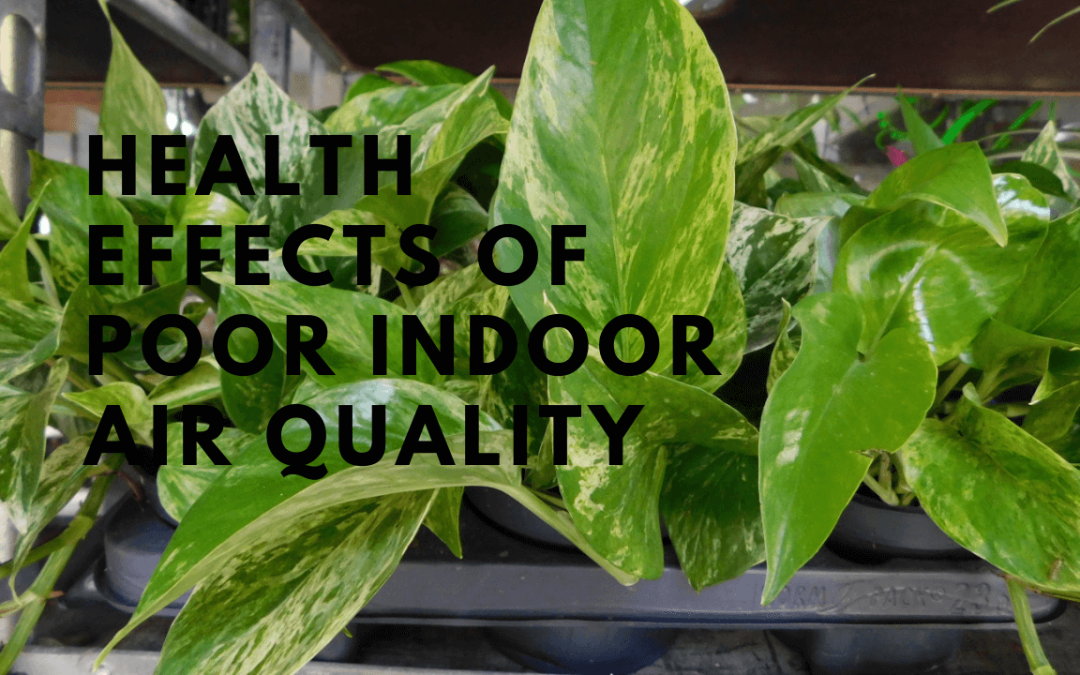“Poor indoor air quality affects us in other ways, too. Our Global CogFx study showed that PM2.5 is associated with lower cognitive test performance” Impacts of Indoor Air Quality on Cognitive Function
Indoor air quality is critical as it directly affects the well-being of individuals within buildings and structures. We understand the significance of clean and healthy indoor air, especially considering the amount of time we spend indoors. Poor indoor air quality can have detrimental impacts on our health, ranging from respiratory problems and allergies to headaches, fatigue, and even more severe conditions like cardiovascular disease and cancer.
Indoor air pollution stems from various sources, necessitating our attention and proactive measures. Combustion appliances, building materials, furnishings, and cleaning products all have the potential to emit harmful pollutants into the indoor air. These pollutants include carbon monoxide, nitrogen dioxide, volatile organic compounds (VOCs), and particulate matter, which can significantly impact our health and well-being.
We recognize the importance of raising awareness about indoor air quality and taking steps to improve it. In this blog post, we aim to delve into the health effects associated with poor indoor air quality, identify the sources of indoor air pollution, and provide practical solutions to enhance indoor air quality. By understanding the risks and implementing effective strategies, we can promote better health, well-being, and productivity for individuals in indoor environments.
By sharing our expertise and encouraging sustainable practices, we aim to empower individuals to prioritize their indoor air quality and create healthier living and working environments. Together, we can foster a greater understanding of the importance of indoor air quality and promote positive actions for a healthier future.
Sources of Poor Indoor Air Quality
We recognize the multitude of sources that can contribute to poor indoor air quality. Understanding these sources is crucial for addressing indoor air pollution and safeguarding the health and well-being of individuals within buildings. Here are some of the most common sources of indoor air pollution:
- Combustion sources: Appliances that rely on fossil fuels for combustion, such as gas stoves, furnaces, and fireplaces, have the potential to release harmful pollutants into the air. Carbon monoxide and nitrogen dioxide are among the pollutants emitted, which can pose significant health risks if not properly ventilated.
- Building materials: Certain building materials used in construction and interior design can introduce volatile organic compounds (VOCs) into the indoor environment. Carpets, paints, adhesives, and sealants are examples of materials that can emit VOCs over time, negatively impacting indoor air quality.
- Furnishings: Furniture made from composite wood products, such as particleboard and plywood, can emit formaldehyde, a known carcinogen, into the air. Formaldehyde exposure can lead to respiratory irritation and long-term health concerns.
- Cleaning products: Many conventional cleaning products contain chemicals that can contribute to poor indoor air quality. Volatile solvents, aerosol propellants, and fragrance chemicals found in cleaning agents can release pollutants and irritants into the air, affecting respiratory health.
- Outdoor sources: Outdoor pollutants can infiltrate indoor spaces, compromising indoor air quality. Pollen, particulate matter, and other outdoor contaminants can be brought indoors through open windows, ventilation systems, and on clothing, impacting the health of individuals within the building.
Health Effects of Poor Indoor Air Quality

We understand the critical role of indoor air quality in maintaining human health and well-being. Poor indoor air quality can have a range of detrimental effects on individuals, including:
- Respiratory problems: Indoor air pollution can irritate the respiratory system, leading to coughing, wheezing, and shortness of breath. For those already suffering from respiratory conditions like asthma and chronic obstructive pulmonary disease (COPD), poor indoor air quality can worsen symptoms and trigger respiratory distress.
- Cardiovascular disease: Prolonged exposure to indoor air pollution can increase the risk of developing cardiovascular diseases, including heart attacks and strokes. The presence of pollutants such as particulate matter and volatile organic compounds (VOCs) can contribute to the development of cardiovascular issues.
- Allergies and asthma: Poor indoor air quality can worsen allergies and asthma symptoms. Airborne allergens, such as dust mites, mold spores, and pet dander, can trigger allergic reactions and asthma attacks in sensitive individuals.
- Headaches and fatigue: Indoor air pollution can cause headaches, fatigue, and difficulty concentrating. Chemical pollutants and insufficient ventilation can contribute to these symptoms, affecting productivity and overall well-being.
- Cancer: Certain indoor air pollutants, such as radon and formaldehyde, have been linked to an increased risk of cancer. Prolonged exposure to these carcinogens can have serious long-term health consequences.
The severity of these Health Effects of Poor Indoor Air Quality various factors, including the type and concentration of pollutants present, as well as individual susceptibility and duration of exposure. We prioritize creating healthy indoor environments by addressing the factors that contribute to poor indoor air quality. By implementing effective strategies for improving indoor air quality, we aim to mitigate these health risks. In the following section, we will explore the factors that influence indoor air quality and provide practical solutions for enhancing the air we breathe indoors.
Factors Affecting Indoor Air Quality

We recognize the crucial role of indoor air quality in ensuring a healthy and comfortable environment. Several factors can significantly influence indoor air quality, including:
- Temperature and humidity: Maintaining appropriate temperature and humidity levels is essential. Excessive heat and high humidity can create a conducive environment for mold, dust mites, and other allergens to thrive, compromising indoor air quality. Conversely, low temperatures and humidity can lead to dry air, which can cause respiratory discomfort and irritation.
- Ventilation: Adequate ventilation is vital for promoting good indoor air quality. Insufficient ventilation can result in the accumulation of indoor air pollutants, while proper ventilation helps to remove and dilute these pollutants, ensuring fresher and cleaner air.
- Chemicals and pollutants: Various chemicals and pollutants can significantly impact indoor air quality. Volatile organic compounds (VOCs), emitted by sources such as paints, adhesives, and cleaning products, can contribute to poor air quality. Additionally, gases like radon and carbon monoxide, which can originate from natural sources or incomplete combustion processes, pose health risks when present in indoor environments.
- Building materials and furnishings: The choice of building materials and furnishings plays a crucial role in indoor air quality. Certain materials, such as pressed wood products and carpets, can release VOCs into the air, negatively affecting air quality. Moreover, materials that promote moisture retention or provide a suitable habitat for mold growth can also compromise indoor air quality.
By understanding and addressing these factors, we can take proactive measures to improve indoor air quality in our homes and workplaces. We promote the use of sustainable and environmentally friendly materials, proper ventilation systems, and regular monitoring to ensure optimal indoor air quality. In the subsequent section, we will delve into practical strategies to enhance indoor air quality and foster a healthier living environment.
Ways to Improve Indoor Air Quality

We recognize the significant impact of indoor air quality on our health and well-being. Improving indoor air quality is crucial, and here are some effective strategies:
- Enhance ventilation: Adequate ventilation is key to maintaining good indoor air quality. Opening windows and doors to allow fresh air circulation can reduce the concentration of indoor air pollutants.
- Utilize air purifiers: Air purifiers equipped with High-Efficiency Particulate Air (HEPA) filters can effectively capture and remove fine particles like dust, pollen, and smoke from the air, improving air quality.
- Manage humidity levels: Proper control of humidity levels is essential to prevent the growth of mold and other allergens. Using dehumidifiers in damp areas and promptly addressing any leaks or water damage can help maintain optimal humidity levels.
- Choose natural cleaning products: Many conventional cleaning products contain chemicals that can contribute to poor indoor air quality. Opt for natural cleaning alternatives, such as vinegar and baking soda, which are effective and environmentally friendly.
- Select non-toxic furnishings: When selecting furnishings, prioritize those made from non-toxic materials. Avoid furniture constructed with particleboard or plywood, as they can emit formaldehyde, which can compromise indoor air quality.
- Regularly replace air filters: Regularly replacing air filters in heating and cooling systems ensures efficient filtration of airborne particles. This simple maintenance task helps improve indoor air quality and safeguards respiratory health.
Conclusion
We recognize the critical role of indoor air quality in our health and overall well-being. Poor indoor air quality can have profound impacts on our respiratory system, cardiovascular health, and overall comfort. It is crucial to take action and improve indoor air quality to mitigate these risks.
Exposure to indoor air pollutants can lead to a range of health problems, including respiratory issues, cardiovascular disease, allergies, asthma, headaches, fatigue, and even an increased risk of cancer. However, there are practical steps we can take to enhance indoor air quality and reduce these risks.
Increasing ventilation is vital to promote air circulation and reduce the concentration of indoor air pollutants. Opening windows and using exhaust fans can help in this regard. Additionally, utilizing air purifiers with efficient filtration systems, such as HEPA filters, can effectively remove fine particles and allergens from the air, ensuring cleaner indoor environments.
Maintaining proper humidity levels is essential to prevent the growth of mold, fungi, and dust mites, which thrive in damp conditions and worsen indoor air quality. Using dehumidifiers in moist areas and promptly addressing any water leaks or damage can help maintain optimal humidity levels.
Opting for natural cleaning products instead of chemical-laden alternatives can significantly reduce the release of harmful substances into the air. Choosing non-toxic furnishings made from sustainable materials, avoiding the use of particleboard or plywood, can help minimize the emission of harmful volatile organic compounds (VOCs).

